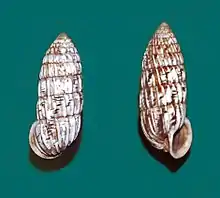Cerion uva
Cerion uva is a species of air-breathing tropical land snail, a terrestrial pulmonate gastropod mollusk in the family Cerionidae, the peanut snails.[1]
| Cerion uva | |
|---|---|
 | |
| Shells of Cerion uva | |
| Scientific classification | |
| Domain: | Eukaryota |
| Kingdom: | Animalia |
| Phylum: | Mollusca |
| Class: | Gastropoda |
| Subclass: | Heterobranchia |
| Order: | Stylommatophora |
| Family: | Cerionidae |
| Genus: | Cerion |
| Species: | C. uva |
| Binomial name | |
| Cerion uva (Linnaeus, 1758) | |
| Synonyms | |
| |
Description
Shells of Cerion uva can reach a length of 24 mm.[2] This species shows extensive, geographical variations in whorl size.[3] The shape of the shell of this species changes very much as they grow. In adults, the shells are beehive-shaped, and have an expanded labrum.[2][4][5]
Distribution
This species is endemic to the islands of Aruba, Curaçao and Bonaire; many populations are quite different in terms of morphology and represent the diverse makeup of infraspecific taxa.[6]

Infraspecific taxa and type localities
In 2014, the constituent forms of Cerion uva were reviewed, and included:[6]
- Cerion uva uva (Linnaeus, 1758) – Type locality: Schaarlo, Willemstad [1285.11′ N, 68854.21′ W]
- = C. uva arubanum Baker, 1924 – Type locality: Baranca Alto [12828.50′ N, 69857.77′ W]
- = C. uva desculptum Pilsbry & Vanatta, 1896 – Type Locality: Curaçao
- = C. uva uva f. hatoensis Baker, 1924 – Type locality: Eastern escarpment of Seroe Spelonk, near Landhuis Hato [12810.71′ N, 68857.92′ W]
- Cerion uva diablensis Baker, 1924 – Type locality: Top of Ronde Klip [1288.98′ N, 68852.02′ W]
- Cerion uva knipensis Baker, 1924 – Type locality: Valley area between Seroes Palomba and Baha
- = C. uva knipensis f. djerimensis ¶ Baker, 1924 – Type locality: Edge of coastal cliffs near Plaja Djermimi [12821.24′ N, 6989.83′ W]
- Cerion uva bonairensis Baker, 1924 – Type locality: Porta Span˜o [12814.06′ N, 68816.68′ W]
- = C. uva bonairensis f. kralendijki ¶ Baker, 1924 – Type locality: South of Kralendijk [1288.08′ N, 68816.68′ W], beside a highway on the western shore of Bonaire
¶ : Denotes that this name was published as an infrasubspecific name intended to distinguish populations within subspecies, thus being an unavailable name according to the ICZN.
References
- WoRMS
- Geerat J. Vermeij A Natural History of Shells
- Stephen Jay Gould The Structure of Evolutionary Theory
- Henry A. Pilsbry and E. G. Vanatta Catalogue of the Species of Cerion, with Descriptions of New Forms Proceedings of the Academy of Natural Sciences of Philadelphia, Vol. 48
- P.Wagenaar Hummelinck About the malacological subdivision of Curaçao; a review
- Harasewych, M. G. (2015-02-01). "Systematics and phylogeography of Cerion sensu stricto (Pulmonata: Cerionidae) from Aruba, Curaçao and Bonaire". Journal of Molluscan Studies. 81 (1): 66–84. doi:10.1093/mollus/eyu062. ISSN 0260-1230.